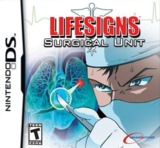Too much focus on the interns' life at the hospital ends up overshadowing the diagnosis and surgical activities.
Tendo is on a date with Suzu, the chief surgeon he has a crush on, when all of a sudden everyone who works at the hospital starts showing up interrupting his romantic moment.
As you soon find out, Tendo had fallen asleep during a slow moment in his night shift at the hospital.
Lifesigns mixes an adventure type of gameplay with the touch-screen surgery procedures we know from Trauma Center: Under the Knife. There is a lot of dialog, character interaction and reading involved, and you will actually spend more time doing this than performing your medical duties.
Talking to staff and patients is a major portion of the game. Dialogs can be initiated by tapping on the person with the stylus. Key items for the conversation will be displayed as icons on a side-scrolling menu, so when you want to talk to someone about a particular topic, you open the menu and drag down the item you want.
Many times advancing the story becomes a process of trial and error where you end up dragging every icon onto someone to see which one is the right one. There are many occasions where you only get a very vague clue as to what to do next, usually followed by a lot of roaming around the hospital and talking to everyone.
It's interesting to get to know the patients and co-workers, and some situations are pretty hilarious. In traditional anime-style, there is a nurse with a thing for gossip, an over-the-top pop star, a very sexy surgeon, an intern who pays more attention to food than anything else, and even an old man with a thing for pinching the girls' butts. Getting to know people is often amusing and the conversations are pretty funny for the most part. Everyone also has a few animations and plenty of facial expressions (unlike Trauma Center), which greatly adds to the dialogs.
This does get in the way of the action, which takes place in the form of a patient examination and then the actual surgical procedure. The patient examination is rather interesting, but limited. You can only use a stethoscope, your hands for palpation and your eyes to look for any bruises or cuts. You are given a schematic of the patient with empty spaces, and that's about it for clues. You must find as many things as the schematic indicates, but you don't really know where to look for them, and usually you only have a symptom or two to work with. For example, one of the patients took me forever to examine because I couldn't figure out the two missing things... I started rubbing the screen everywhere and eventually found out I had to check out her pulse on her wrist, with no result, so logically I had to check it on her neck. And, keep in mind that when a patient says "it hurts more to the right", that means their right, not yours.
You also get to check ultrasounds and x-rays by circling the differences so that you are able to complete your diagnosis. I'm actually using the game as a learning tool as far as medical terminology goes for my interpreter training, so aside from entertaining, it's also been very educational for me. If you are not familiar the terms, you might have a hard time understanding certain things.
As for surgery, all I can say is that just when I thought Trauma Center was hard, Lifesigns comes along. But mostly because of the electrical scalpel, which is very hard to get working properly and not burn too much, and the forceps... for some reason, I kept "dropping" whatever when I could swear it was already in place.
Tendo has the ability to focus during surgery, making it easier to perform certain procedures. By pressing either the left or right triggers, you see a guideline that tells you where to cut, drill or burn. The surgery is very in-depth, there's even a reanimation process where you use the triggers as the defibrillator paddles, if the patient's vitals drop.
Now and again, you will also find yourself out of the hospital doing a few other activities and participating in some mini-games (the first one being catching fruit that fell from a truck on the road).
Lifesigns has a very good presentation. The anime-style artwork is great, the characters are very expressive and have some animations as well, and the surgeries show pretty realistic versions of internal organs. The sound effects are appropriate, the soundtrack is passable, but unfortunately there is no voice acting.
Lifesigns: Surgical Unit is an interesting medical drama with a bit too much focus on the interns' life at the hospital, which ends up overshadowing the diagnosis and surgical activities. But if you like the genre and enjoy anime, you should have no problem with it.
Review text part of Grrlgamer.com. Full text, screenshots and trailer at http://www.grrlgamer.com/review.php?g=lifesigns

